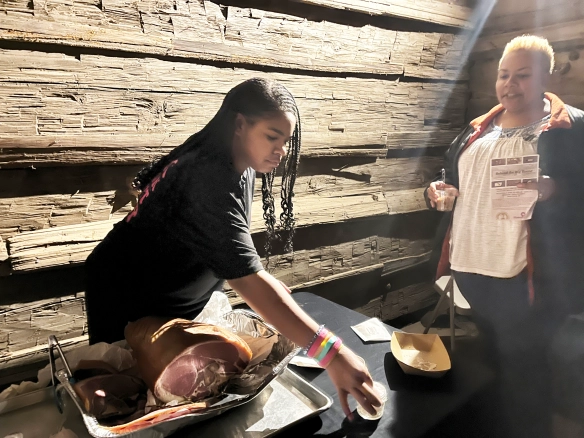Courtesy of the University of Arkansas at Pine Bluff
Students of the University of Arkansas at Pine Bluff’s Hospitality and Tourism Management Program had the chance to help give high schoolers and members of the public an up close and personal look at African American history when they participated in the recent “Behind the Big House” event in Winchester, Arkansas. Held at the historic Taylor House and Hollywood Plantation, the interactive program allowed visitors to learn about the lives and experiences of the enslaved people who lived at the property, which once spanned more than 10,000 acres across Desha, Drew and Lincoln counties.
The student participants from UAPB’s Department of Human Sciences included Maria Bradley, Jared Sims and Caron Gill. They were accompanied by Dr. Suzzette Shaw Goldmon, assistant professor and coordinator for UAPB’s hospitality and tourism management program, and Teki Hunt, director of UAPB’s 4-H Program.
Dr. Goldmon said the Behind the Big House event is part of educational programming by Preserve Arkansas, the only statewide nonprofit advocate for the preservation of Arkansas’s historic places.
President of Preserve Arkansas, Dr. Goldmon formerly served as the chair and director for the University of Arkansas at Monticello Hospitality and Tourism Initiatives Program and helped establish the educational site at the Taylor House and Hollywood Plantation and worked on the interior design of the property. She said the Behind the Big House event was a way to allow local high schoolers and other visitors from across the region see what life on the plantation was like from the perspective of the enslaved people who worked and lived there.
Dr. Goldmon said the event featured a wide variety of workshops including a hands-on cooking session celebrating Black food traditions from Africa to America. Another cooking session showed participants how enslaved people in the Arkansas Delta cooked over an open fire. UAPB participants demonstrated food preservation techniques such as salting, smoking and canning.
Other sessions covered the preservation of historic cemeteries and the importance of African American genealogy. One workshop detailed the history of the Taylor House and its construction, while an archeology-based workshop highlighted artifacts and faunal remains found near the Taylor House and explained how these objects help paint a picture of how enslaved people lived.
“Behind the Big House is an important program because it focuses on, an aspect of our history – slavery – that is often omitted from the narrative at historic sites and museums,” Rachel Patton, executive director for Preserve Arkansas, said. “Without this part of the story, it is impossible to understand the history of our state and nation. By introducing young people to history in an engaging format, we encourage appreciation for our historic resources like buildings and cemeteries, contribute to their understanding of the past and its implications on the present, and make them more well-rounded citizens.”
Patton said participants of the Behind the Big House event included people from all over the state, as well as visitors from Mississippi and Louisiana.
“I’ve heard positive feedback from nearly every participant,” she said. “They particularly enjoyed the interactive stations associated with foodways, as well as our Friday night speaker, James French, founder of the Montpelier Descendants Committee, and the fireside chat with Joseph McGill and Herb Frazier of the Slave Dwelling Project.”
Matthew Rooney, research station archeologist for the Arkansas Archeological Survey and vice president for Preserve Arkansas, led the education committee for the Behind the Big House event.
“The event shed a bright light on Black history in the American South, particularly the history of enslaved people and their descendants who worked as sharecroppers and general laborers,” he said. “These were incredibly important moments for the Arkansas Delta given that this history is little explored and even less told outside of academic literature.”
In addition to the 100 high school students from Monticello that participated in the recent event, in 2022, middle school students from Dumas, Arkansas were able to visit the historic site, he said.
“All were able to participate in live demonstrations of African American lifeways, including food processing and storage, have hands-on experience with the residues of agricultural labor through archeology and visit one of hundreds of lost African American cemeteries lost to the woods in the wake of the great migrations of the 20th century,” Rooney said. “In addition to exposing Delta youth to these important aspects of history, the event has provided a venue for the public in Arkansas to come to terms with the difficult legacy of slavery, which still hangs over the South, whether or not people choose to acknowledge it.”
According to Rooney, robust attendance at Behind the Big House demonstrates that Arkansans are not afraid to engage in meaningful discourse about terrible episodes in American history.
“We see in plain view that historic properties built by enslaved laborers using their intellect and ingenuity should be celebrated for what they contribute to global human history and culture,” he said.
Dr. Goldmon said Preserve Arkansas’ Behind the Big House was made possible thanks to partners including UAPB, the Arkansas Archeological Survey, Humanities AR, Preservation of African American Cemeteries, Inc., the Arkansas Historical Association, the University of Arkansas at Monticello and Kudzu Collective.
The University of Arkansas at Pine Bluff offers all its Extension and Research programs and services without regard to race, color, sex, gender identity, sexual orientation, national origin, religion, age, disability, marital or veteran status, genetic information, or any other legally protected status, and is an Affirmative Action/Equal Opportunity Employer.

